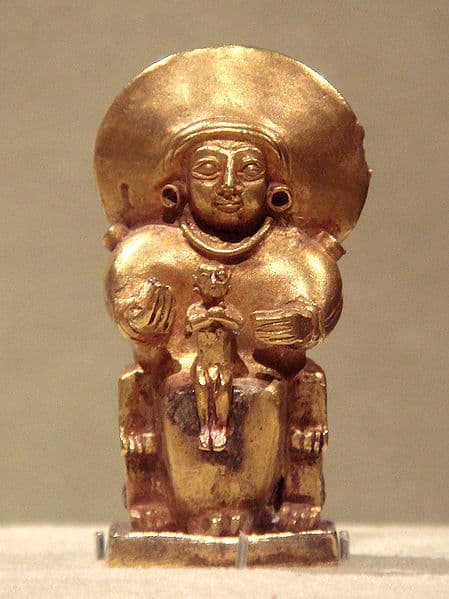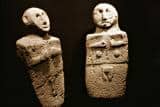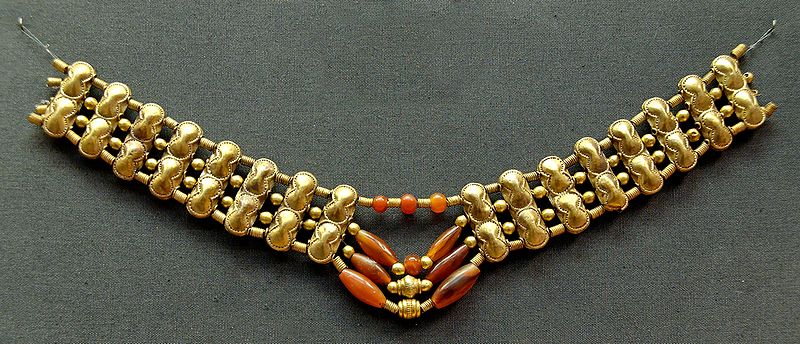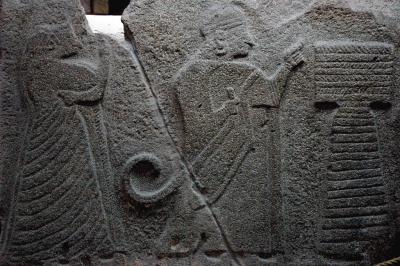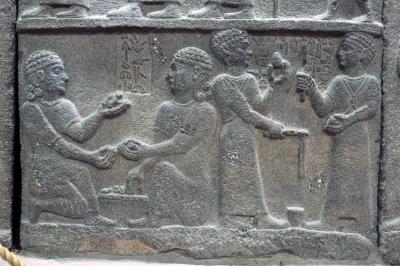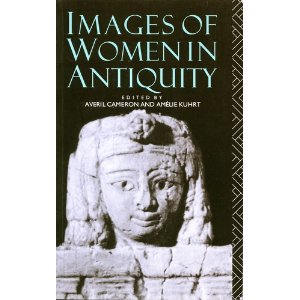Trojan Women: Women’s Roles in Ancient Anatolia and Mycenaean Greece Part III
You may wish to read the introduction of this series
Trojan Women: Women's Roles in Ancient Anatolia and Mycenaean Greece or Part I
What Hittite and Mycenaean Women "Did" or Part II
A Woman's View From the Top: Hittite and Mycenaean Queens
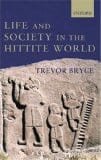
Describing the Hittite
hasawa to a modern audience is a challenge. Much of what she does seems utterly bizarre to us, and the variety of her duties appears to escape logic as a single profession. To understand the role of the
hasawa is to begin to see through ancient Hittite eyes.

Trevor Bryce, one of the pre-eminent historians of the Hittites, describes the
hasawa in this way:
“Prominent amongst the experts in ritual procedure, which included many males, were a group of female practitioners whom we commonly refer to as the ‘Old Women’, misleadingly so if the term conjures for us the notion of a pack of toothless, half-crazed old crones. The Hittite term for them is
hasawa, perhaps originally used of midwives, since it literally means not ‘old woman’ but rather ‘(she) of birth’. At all events the women so designated were multi-skilled professionals who may often have collaborated with doctors, augurs, incantation priests, and other practitioners in the arts of ritual performance, healing, and divination. As was the case with scribes, many may have been continuing a family tradition, inheriting an occupation which in some cases at least appears to have been passed down through successive generations of the same family. The names of fourteen of these women have survived, as authors of rituals which they practiced. The women in general were almost certainly literate, and may well have been multilingual to a greater or lesser degree. …
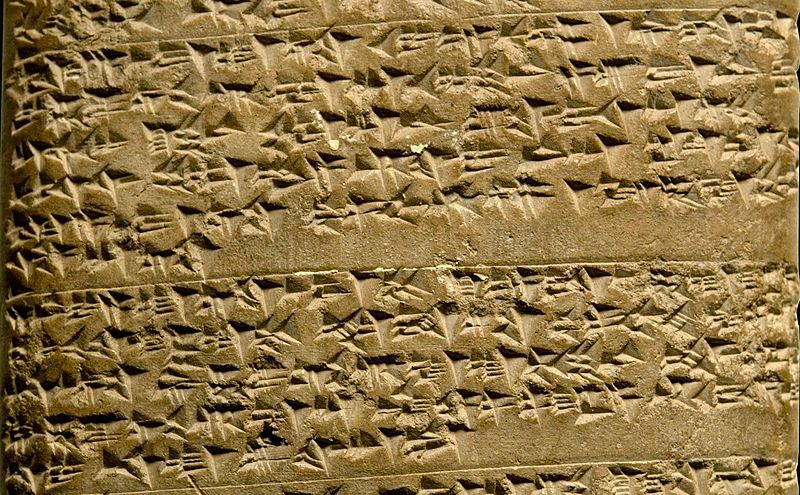 |
| Closeup of Hittite cuneform writing like the tablets the hasawa composed (Photo copyright J. David Hawkins, Wikimedia Commons) |
 |
| Sheep for sacrifice and wool (Photo copyright Jack Hynes, Wikimedia Commons) |
“It is not unlikely that the ‘Old Women’ (to keep the conventional term) had a regular consultancy practice covering a wide range of situations, and presumably access to a considerable source of material on which they could draw in performing a ritual appropriate to a particular situation. Even at the humblest level rituals were complicated affairs, given all the paraphernalia required for their successful accomplishment, including foodstuffs and other consumable items of clay, wax, tallow, and wool, animals for sacrifice, and a range of ritual instruments. The slightest error could invalidate the whole procedure. Ritual texts … have the appearance of step-by-step instruction manuals, for careful consultation by the practitioner at every stage of the process—the collection of all the materials required for the ritual, their conveyance to the place where the ritual was to be performed, the time of the performance, the words to be uttered, the chants to be sung, the procedures to be followed in meticulous detail. There was obviously a limit to how much the ritualists could commit to memory, even when they themselves had authored a particular ritual. And there may have been many cases where a situation arose with little or no warning. Almost certainly there was a large stock of recorded material on which they could call, to ensure that they always had something ready to hand for every conceivable occasion.” (Bryce, 201-202)
To refer to the
hasawa as the “Old Woman” is not useful at all—her age can be young or old and it does not describe what she does—but a good translation is hard to come by. I came up with the term “healing priestess” when depicting my legendary/fictional
hasawa, Briseis, in my novel. I’ll organize this article by describing the different duties—or at least a selection of them—which we find in the Hittite records for a
hasawa.
Priestess of Divine Reconciliation and Ritual User of Myth
This “duty” of a
hasawa is perhaps the toughest one for us to understand. It is also, I think, the most essential if we are to grasp the importance of this woman in Hittite society. Without the services of the
hasawa, Hittites believed the human and divine worlds would be fatally out of harmony, and they would have no means to restore balance.
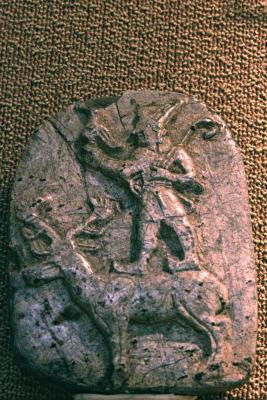 |
| Stone relief of a Hittite god standing on a stag (Photo by Dick Osseman) |
For the Hittites, the gods had to be present in their world for prosperity and well-being to flourish. They feared the departure of the gods, or of any one god, and the dire consequences that would result (Popko). One common thread in Anatolian (i.e. Hittite and surrounding peoples) mythology is the vanishing god who retreats from the world in anger. One version describes the results of the god’s withdrawal in this way: “Mist seized the windows, smoke seized the house. In the fireplace the logs were stifled…The god went away and removed grain, animal fecundity, luxuriance, growth…Therefore barley and wheat no longer ripen. Cattle, sheep, and humans no longer become pregnant…The pastures and the springs dried up, so that famine broke out in the land. Humans and gods are dying of hunger” (Popko). One thing to notice in this description is the interdependence of gods and humans—gods can starve just as humans can, and they both have to solve the crisis.
 |
| The hasawa laid out apple blossoms as a path to bring home the angry god (Photo copyright Fir0002 Flagstaffotos, Wikimedia Commons) |
It became the job of the
hasawa to release nature from this stifling and starvation. The
hasawa attempted to bring the god back through “attraction” by laying out good food and drink and sweet honey.
She marked the path “back home” by laying out branches and textiles stretching in all directions. She performed a variety of elaborate procedures such as sacrifices. But more important than any of these actions, she accomplished her goal primarily through her words. There was a Hittite proverb, “the tongue is the bridge”—that is, the bridge between god and mankind. She told the story of finding the missing god, appeasing him, and releasing his anger. Indeed, we have these myths preserved because they were included in the directions for her rites. The telling of the myth itself acted as magic by analogy. Just as in the myth where the gods and goddesses find and sooth the angry god and return him to his proper place, so the
hasawa’s telling accomplished the same role for any god who might be out of harmony, whether the
hasawa knew the identity of this god or not. Her role as reciter of the tale was parallel to the gods and goddesses within the myth. Thus the
hasawa ensured the community’s (or sometimes an individual’s) well-being through her ritual practice.
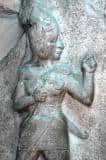 |
| Hittite god of the young warrior type such as Telipinu (Photo by Dick Osseman) |
The most common “vanishing” god was Telipinu, who as the son of the Stormgod (the closest thing to a “chief” god in the Hittite “pantheon of a thousand gods”) was in charge of rain, crops and herds. In one of these rites to appease the god and reconcile him with humans, the
hasawa addressed Telipinu with these words: “Just as an olive holds its oil in its heart, just as a grape holds its wine in its heart, so you must hold goodness in your soul and heart in the same way….Telipinu, let anger go, let wrath go. And just as the water in a drain pipe doesn’t flow backward, so may the anger, wrath, and sullenness of Telipinu likewise not come back” (Popko). The ritual continued with a description of idyllic reconciliation and fertility. By saying it, the
hasawa made it true. Her words had tangible power.
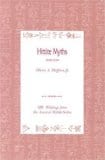
I find this use of myth fascinating. We tend to think of mythology as a sort of literature vaguely associated with religion in some distant time, but not really.

For the Hittites, the sacred tales were the source of their connection to the gods. I suppose this is not entirely unlike a Catholic priest announcing that the wine and bread are now literally the blood and body of Jesus, but for the most part, I think we have lost this sense of the power of word and story. If you are interested in Hittite myth, read my
review of Hittite Myths, Harry Hoffner, Jr..
Family Therapist
For the
hasawa, a quarrel within a family was an illness just as much as a swollen eye. To our modern mind and procedures, these are definitely different—talk therapy treats one and an ointment applied to the eye or a swallowed pill cures the other. But to the Hittite these problems were caused by a mixture of contamination and disharmony, and their cures used a similar array of tools. A potion or poultice might be involved for either, and words were always the most powerful medicine. The
hasawa created substitutions—a model of a tongue, for example—onto which the source of the disagreement could be placed and then removed from the quarreling parties. The logic went, if two people hurt each other by saying mean words, we can put the mean words onto a substitute tongue and fling it away. And as long as the
hasawa announced to the gods with her words exactly what she intended to accomplish with this procedure—she never left it up to the gods to figure this out—the quarreling parties would be reconciled. You can see where this might indeed be powerful psychological medicine.
Here are excerpts from one text in which the
hasawa acts as “family therapist.” The whole procedure in the version I have lasts for three pages, so I’ve selected only some highlights. Generally speaking, in Hittite religious procedure if something worked well once, it would work even better repeated/varied one hundred times. Days and weeks long rituals were not at all uncommon.
“These are the words of Mastigga, the woman from Kizzuwatna: If a father and (his) son, or a husband and his wife, or a brother and (his) sister quarrel, when I reconcile them, I treat as follows:
She takes black wool and wraps it in mutton fat;
tissatwa they call it. She presents it to the sacrificer [i.e. the quarreling persons who asked for this procedure] and speaks as follows: ‘Whatever thou spokest with (thy) mouth (and) tongue—see, here is
tissatwa! Let it be cut out of your body these days!’ She throws the tongues into the hearth.
 |
| Drawing reconstruction of a megaron hall with central hearth found in Mycenaean and Hittite palaces (Copyright Ken Russell Salvador, Wikimedia Commons) |
…
The Old Woman speaks as follows: “In whatever curses you indulged, let now the Sun-god turn those curses (and) tongues toward the left!’ And she throws them into the hearth.
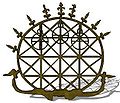 |
| Sun disk representing the Hittite Sungod (Copyright Sahir Seker, Wikimedia Commons) |
The red wool (and) the blue wool that had been placed upon the bodies of the two sacrificers, the two figures of dough that had been placed before them, and the hands and tongues of dough that had been placed upon their heads, those the Old Woman removes. She cuts the strings off them, the Old Woman breaks the two hands and the tongues of dough to pieces.
She then waves them over them and speaks as follows: ‘Let the tongues of these [days] be cut off! Let the words of these days be cut off! And she throws them [into the hearth].
…
They drive up a (white) sheep. The Old Woman presents it to the two sacrificers and speaks as follows: ‘Here is a substitute for you, a substitute for your persons. Let that tongue and that curse stay in (its) mouth!’ They spit into its mouth.
She speaks as follows: “Spit out those evil curses!’ They dig a hole in the ground, cut the sheep up over it, and then put it into it.
They put 1 thin sacrificial loaf down with it, she also pours out a libation of wine and they level the ground.
…
She speaks as follows: ‘Let the evil words of mouth (and) tongue be rubbed away from you!” (Unal, 67-69)
In these excerpts of the ritual, you can see the
hasawa creating a substitution upon which the harm can be attached and then sending it away. In this ritual these substitutions, such as the “tongues” made of fat and black wool or the figures of dough or the sheep’s mouth, are also examples of curing by analogy. This tongue is like the ones that said hurtful words, so if I cure this substitute tongue, I will also cure the real “tongues.” I am reminded of the old punishment of washing a child’s mouth out with soap when they have used a curse word. The
hasawa had a similar notion of purification, only without the vindictiveness!
Healer and Medical Practitioner
 |
| Mullein flowers, an herb used in the ancient world to cure breathing problems (Copyright Alvesgaspar, Wikimedia Commons) |
In the Hittite records we read of more than one kind of medical person or healer, both male and female. Sometimes more than one of these practitioners would assist each other with a patient. The
hasawa used things we would call “medicine” or “medical procedures” although many of these may not have been terribly effective. She, like many healing practitioners in traditional societies, had a store of knowledge about medicinal herbs, roots, and minerals. Throughout the Near East, beer, wine, and oil occur frequently in medical prescriptions. All are known to have genuine healing properties. Linen bandages would be laid upon wounds or swollen areas often with a poultice of some sort (animal fats, wine dregs, sulfur, ground roots are mentioned in various Hittite and Near Eastern texts). In traditional societies herbal medicines were most commonly used to treat gastrointestinal, dermatological and respiratory ailments (Biggs, 1914).
The
hasawa used the principle of analogy in these cures just as she did with curing a quarrel or the disappearance of a god. “For example, fat, tallow, or wax might be melted or objects might be crushed underfoot or incinerated. The objects to be melted, crushed, or burned represented the evil to be eliminated, so that these actions were seen as diverting the evil from the [sick person]. Analogic magic always includes an oral component, an incantation, that establishes the magical connection between the evil and its model” (Frantz-Szabo, 2012).
Here is a description from the tablets of one healing procedure the
hasawa performed on the royal family (and apparently their palace!):
“Then the
hasawa takes a soap plant … and crushes it underfoot, thereby flattening it. A single lump is fashioned from this. Then she presses this on all the limbs of the king and queen…and she speaks as follows: As this soap plant cleanses soiled garments and these (thereby) become white, (thus) may it likewise purify the limbs of the king, the queen, the princes, and also the palace” (Frantz-Szabo, 2012).
 |
| Mouse (Copyright Jens Buurgaard Nielsen, Wikimedia Commons) |
Pain and other illness could be sent away on a “carrier” such as a mouse. The
hasawa “wraps up a small piece of tin in a bowstring and attaches it to the patients’ right hands and feet; then she takes it off again and attaches it to a mouse, saying: ‘I have taken the evil off you and attached it to this mouse. Let this mouse carry it on a long journey to the high mountains, hills and dales’”(Gurney, 50).
As a remover of evil, the
hasawa also undid any “black magic” such as a curse, which was often seen as the underlying cause of illness. Because caves and springs were understood to give access to the Underworld, the
hasawa would go to one of these places, take the impurity caused by sorcerers from the patient and condemn it to never-ending isolation in the depths of the earth buried in bronze vessels called
palhi that were sealed with lead and latches of iron (despite being the “Bronze Age” the Anatolians already used iron in some limited ways) (Popko).
 |
| A cave with a spring such as those where Hittites believed curses could be locked away in the Underworld (Photo copyright Helmut Schütz, Wikimedia Commons) |
The
hasawa was trained to devise new cures and rites as needed, to apply the myths in creative ways in order to restore the well-being of the sick individual or community. We have as much information about these women as we do because they authored new rites and recorded them, both, we assume, for their own personal reference and for the use of future generations of healers.
Diviner
 |
| Minoan (not Hittite) statue (ca. 1600 BC) of either a snake priestess or snake goddess, showing the importance of snakes in ancient Mediterranean religions (Copyright George Groutas, Wikimedia Commons) |
For the Hittites, the gods sent illness or other misfortune when a man or woman sinned. In order to heal or avert the anger of the gods for this sin, a diviner had to read the will of the gods. There were many kinds of seers and diviners in ancient Anatolia. They consulted the stars, birds, the innards of sacrificial animals, and dreams among other things. We hear of the
hasawa mostly in terms of two kinds of divinations: “lot-oracles” and “snake divinations.” The lot oracle seems to have involved some kind of board with symbols drawn on it representing various aspects or activities in life (Bryce, 151) and perhaps dice, but it also lasted for multiple days, so put aside your vision of a Ouija board! The snakes were released into a basin filled with water and marked out in sections such as ‘life’ ‘sin’ ‘temple’ (Bryce, 151 and Frantz-Szabo, 2017). In both of these the format appears to have been a series of yes and no questions asked by the
hasawa or the “sinner,” and then the answer was interpreted by the
hasawa from the movement of the lots or the snakes. I assume this was a very embarrassing process in which the “sinner” had to ask such things as “When I ordered my older brother killed so I could take over the kingdom, did I anger the gods?” For the “sinner” it was either reveal old crimes and misdemeanors or die of excruciating disease. It makes the indignities of hospital gowns and blood drawings sound pleasant.
Midwife
It is likely that the
hasawa originated as a midwife. The Hittite verb “
has” means “to give birth” and, indeed, the
hasawa attends on women in labor as one of her duties. There are other midwife attendants in the Hittite lexicon such as “
hasnupallas” which means “one who is skilled in causing to give birth” (Pringle). The texts that mention these women come from different periods, so perhaps terms changed over time. Occasionally two different attendants are present, other times the
hasawa or the
hasnupallas works alone. Nowhere are their duties clearly delineated. But a job description for the
hasawa would include some version of midwife.
 |
| Hittite midwives recited the myth of the Moongod Armas (Photo copyright Adam Cebula, Wikimedia Commons) |
The midwife’s duties included preparations before, during and after the birth. Presumably she had practical knowledge about delivering babies—we know she used a birthing stool for the mother and sat on a stool herself, used three pillows and a knife in the project—but what we hear about from the tablets are rites to purify and protect the mother and child. Rites were performed to purify the birth stool and wooden pegs that were bound somewhere, perhaps to the birth stool itself. “She beseeches the gods to remove evil influences and to grant a desirable fate to the child” (Beckman 1993, 38). The midwife recited the myth of the Moongod Armas who protected the mother of his child in her difficult delivery, another example of using myth to bring about magic by analogy. In one tablet she takes the combs used to card sheep’s wool and “combs” the body parts of the child to heal them after birth. There was an “Incantation of Crying Out” and one to induce the child to leave the body of the mother. (Beckman 1983)
The blessing which the
hasawa said over the new baby is a fitting way to end an article examining the remarkable importance of this woman’s job in Hittite society. If the baby was a boy, the
hasawa said, “Let a female child be born in a year forth.” Female children were apparently as welcome to a Hittite family as a male child (Pringle).
Bibliography for this article: (Click on book covers to browse or purchase at Amazon)
| Beckman, Gary. “Hittite Birth Rituals” in Studien zu den Bogaskoy-Texten 29. Wiesbaden: Otto Harrassowitz, 1983. |
Beckman, Gary. “From Cradle to Grave: Women’s Role in Hittite Medicine and Magic,” Journal of Ancient Civilizations 8, 1993, 25-39. |
Biggs, Robert. “Medicine, Surgery, and Public Health in Ancient Mesopotamia” in
Civilizations of the Ancient Near East, edited by J.M. Sasson, K. Rubison, J. Baines, 2007-2019. New York: Scribner’s, 1995.
Bryce, Trevor.
Life and Society in the Hittite World. Oxford: Oxford University Press, 2002.
Frantz-Szabo, Gabriella. “Hittite Witchcraft, Magic, and Divination” in
Civilizations of the Ancient Near East, edited by J.M. Sasson, K. Rubison, J. Baines, 2007-2019. New York: Scribner’s, 1995.
| Popko, Maciej. Religions of Asia Minor. Warsaw, 1995. |
Gurney, O.R.
Some Aspects of Hittite Religion. Oxford: Oxford University Press, 1977.
Pringle, Jackie. “Hittite Birth Rituals” in
Images of Women in Antiquity, edited by A. Cameron and A. Kuhurt, Chapter 9. London: Routledge, 1993.
Űnal, Ahmet. “The Role of Magic in the Ancient Anatolian Religions” in Essays on Anatolian Studies in the Second Millenium B.C., edited by H.I.H. Prince Takahito Mikasa, 64-75. Bulletin of the Middle Eastern Culture Center in Japan, Vol. III, 1988.
***
Once again we welcome Judith back to this blog. Judith is a novelist and book reviewer who sets her
historical fiction and mysteries in the period of the Trojan War and the
Hittite Empire. She blogs on these and other topics, as well as
reviewing books, here. She can also be found on Twitter and on Facebook.
Thank you again, Judith, for this fascinating look at women in the ancient world. And readers, we'll have one more post in this series coming soon.
 |
| Judith Starkston |
|

